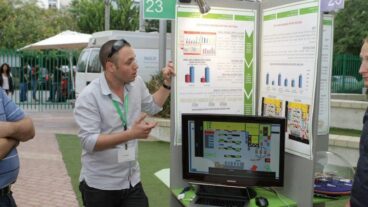Applied Spectral Imaging’s technology applies the techniques of advanced genetic study to the examination of cells for cancer, tuberculosis and other diseases.You won’t find many professionals in the field admitting it, but the awful truth is that pathology is not an exact science, and mistakes are made – too many mistakes, according to Limor Shiposh, CEO of Migdal Ha’emek’s Applied Spectral Imaging (ASI).
That’s why pathologists need a “second opinion,” and ASI wants to help them, with a groundbreaking product that applies the techniques of advanced genetic study to the examination of cells for cancer or other diseases.
ASI, a privately held company founded in 1993, has been in the medical imaging business for over 12 years, pioneering the area of advanced imaging in cytogenetic research, the science of chromosomes and cell division.
ASI’s highly acclaimed innovation in this area, SpectraCube, is a light-related spectral imaging platform technology used in a variety of the company’s products. It allows researchers to distinguish between different materials on a chromosome by highlighting its features with unique colors, instead of the black dye that had been used previously.
Better identification
Using the SpectraCube family of products, researchers find it far easier to identify minutiae of chromosomes and cells, as well as to build a database of information based on their findings.
By now, there are a number of advanced imaging techniques in the area of cytogenetic research – thanks in no small part to the innovations by ASI. But while spectral imaging has done wonders for cytogenetics, Shiposh tells ISRAEL21c, ASI realized that nobody was doing anything for pathologists – and the tools developed by the company were just what they needed to do their job more efficiently and accurately.
“Hard as it is to believe in 2008, pathology is still largely a ‘manual art’ instead of a digitized science,” Shiposh explains. “The pathologist takes a slide with blood or other material and examines it, running tests that are decades old and often looking at a tiny dot that indicates a problem on a cell. It’s a high stress job, and it’s an open secret that there are many mistakes and misdiagnoses, although many of them are not documented.”
Based on a pathologist’s readings, surgeons and specialists like oncologists make specific decisions on the method of dealing with tumors, for example – and in some cases a misdiagnosis can prove life threatening.
So what’s the holdup? Why haven’t modern imaging methods been widely implemented for pathologists?
“Because pathologists are used to working in a specific way, centered on their microscopes,” says Shiposh. “Our research has found that other companies that have tried to implement changes in pathologists’ work routines have met with sharp resistance.” And while the older generation of pathologists has been especially reluctant to adopt computerized techniques, younger pathologists, many of whom have grown up with computers, “understand how imaging can help them in their work, and are ready to adopt new systems,” says Shiposh.
A check on suspicious findings
With this in mind, ASI is applying its expertise in cytogenetics to develop products to help pathologists deal with their thorniest dilemmas. Among the first products launched this year aimed at pathologists, for example, is ASI’s TB Finder, to aid in the diagnosis of tuberculosis. “Tuberculosis is often especially difficult to find, and is one of the more misdiagnosed diseases. According to regulations, pathologists are supposed to spend as much as 30 minutes checking samples, but many don’t because they’re short on time,” says Shiposh.
Instead of taking a chance, pathologists can run their samples through TB Finder, which will highlight the various elements with different colors. “The pathologist can run the usual tests on samples and work in the usual manner, but as backup – as a second opinion, to check out a suspicious sign – he or she can run their findings in the TB Finder to ensure quality work,” Shiposh says.
In addition to TB Finder, ASI is already selling or planning to market additional tools for pathologists, including PathEx, as well as for morphologists, who examine protein structures and alterations in cell structures.
ASI, which employs 33 and has subsidiaries in California and Germany, isn’t the only company promoting digital pathological examination methods, but it is among the more successful, Shiposh says. That’s not surprising, given the billions of dollars in billing for pathology work annually, just in the US.
“Our imaging systems are modular, meaning they can be implemented to the extent the pathologist feels comfortable with. If he or she prefers traditional methods, they can use our tools to supplement their work,” Shiposh says, or use the ASI tools more extensively.
“We realize that one size doesn’t fit all, especially for pathologists,” says Shiposh. “The main thing is to promote better work habits in the profession.” And, maybe, save some lives while they’re at it.












